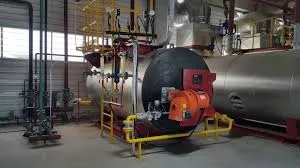
Dec . 07, 2024 08:20 Back to list
hot water boiler schematic diagram
Understanding Hot Water Boiler Schematic Diagrams
Hot water boilers are essential components in heating systems, providing warmth for residential and commercial buildings. Understanding the schematic diagram of a hot water boiler is crucial for diagnosing issues, conducting maintenance, and ensuring efficient operation. This article will delve into the various components represented in a typical hot water boiler schematic diagram and discuss their functions.
Components of a Hot Water Boiler Schematic Diagram
A hot water boiler schematic diagram typically includes key elements such as the boiler itself, heating elements, pumps, and piping systems. Each of these components plays a vital role in the overall function of the heating system.
1. Boiler Unit At the core of the schematic is the boiler unit, where water is heated. It can be powered by natural gas, oil, electricity, or other fuel sources. The diagram signals different types of boilers, such as fire-tube or water-tube designs, each with its distinct flow patterns and heating capability.
2. Heat Exchanger Connected to the boiler, the heat exchanger allows heat transfer from the fuel combustion process to the water. In a typical system, the heat exchanger may be a series of tubes or plates that maximize surface area and efficiently transfer heat.
3. Circulating Pump The schematic will also depict a circulating pump, which is essential for maintaining water flow throughout the heating system. The pump moves hot water from the boiler to radiators or baseboards, ensuring that heat is evenly distributed within the building.
4. Expansion Tank A necessary safety feature, the expansion tank accommodates the increase in water volume that occurs when it is heated. This prevents excessive pressure buildup within the system, which could lead to failures or leaks.
5. Pressure Relief Valve This component is critical for ensuring safety. The pressure relief valve opens when the pressure inside the boiler exceeds a predetermined limit, releasing excess pressure and preventing potential hazards.
hot water boiler schematic diagram

6. Thermostats and Controls The schematic will typically illustrate various controls and thermostats, which regulate the boiler’s operation based on the desired temperature settings. Digital controls may offer more advanced features, including programmability and remote monitoring.
7. Piping Layout The piping connecting all components is also a significant aspect of the diagram. It indicates the flow of water, both incoming and outgoing, showing how the system circulates heated water through various circuits to radiators or other heating devices.
Visual Understanding
Schematic diagrams can vary in complexity, but they are designed to convey information quickly and effectively. Using symbols and lines, these diagrams create a visual representation of how each component interconnects. Familiarizing oneself with these symbols is essential for anyone involved in the installation, maintenance, or troubleshooting of hot water heating systems.
Importance of Schematic Diagrams
Understanding the schematic diagram of a hot water boiler is crucial for several reasons
- Troubleshooting Technicians can quickly identify problems by understanding how components interact and pinpointing where failures may have occurred. - Maintenance Regular maintenance can be planned more effectively with clear diagrams, allowing technicians to foresee potential issues and perform preventive actions. - System Design Engineers and designers use schematic diagrams to plan efficient heating systems, ensuring they meet the necessary heating loads and safety standards.
Conclusion
Hot water boiler schematic diagrams provide a fundamental overview of the heating system's structure and operation. By understanding these diagrams, individuals can better maintain and troubleshoot their heating systems, ensuring optimal performance and safety. Whether for residential use or larger commercial applications, a comprehensive grasp of the schematic can lead to enhanced energy efficiency, longevity of equipment, and a comfortable indoor environment. Investing time in learning and interpreting these diagrams is, therefore, invaluable for anyone dealing with hot water heating systems.
-
High-Efficiency Commercial Oil Fired Steam Boiler for Industry
NewsJul.30,2025
-
High-Efficiency Biomass Fired Thermal Oil Boiler Solutions
NewsJul.30,2025
-
High Efficiency Gas Fired Thermal Oil Boiler for Industrial Heating
NewsJul.29,2025
-
High-Efficiency Gas Fired Hot Water Boiler for Sale – Reliable & Affordable
NewsJul.29,2025
-
High Efficiency Biomass Fired Hot Water Boiler for Industrial and Commercial Use
NewsJul.29,2025
-
High-Efficiency Biomass Fired Hot Water Boiler for Industrial Use
NewsJul.28,2025
Related PRODUCTS






















